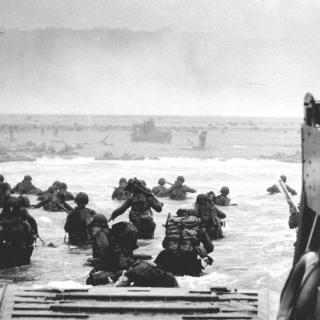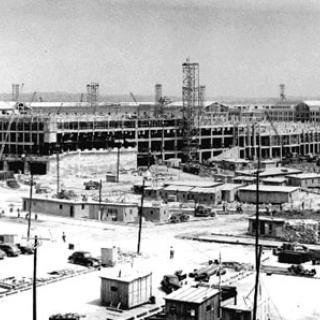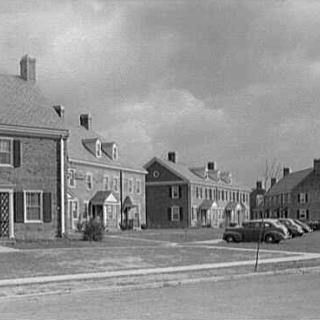The Torpedo Factory Art Center: Alexandria's World War II Landmark
Silently sitting on the waterfront of the Potomac River, the 85,000 square foot Torpedo Factory Art Center at 105 North Union Street in Old Town Alexandria is a landmark of Northern Virginia history. Today, the Torpedo Factory houses artist studios, galleries, art workshops, and even an archeology museum. Yet during the tumultuous years of America’s involvement in the Second World War, workers produced a different form of art within the Torpedo Factory’s walls – the Mark 14 submarine torpedo used by U.S. Navy personnel in the Pacific theater of the war. Over 70 years after its decommissioning as a munitions depot, the history of the Torpedo Factory is a fascinating tale of politics, faulty weapon engineering, and local spirit.
Construction on the Alexandria Naval Torpedo Station began on November 12, 1918, one day after Armistice Day ended hostilities in World War I. Early on, Alexandria shared its responsibilities for manufacturing and maintaining torpedoes and weapon ordnance with the primary Naval Torpedo Station located on Goat Island in Newport, Rhode Island. Goat Island housed the Bureau of Ordnance, the organization responsible for the Navy’s primary weapons development and research. In an attempt to keep money and resources flowing to the Torpedo Station on Goat Island, Congressional delegations from several New England states convinced Congress to cease production at Alexandria and focus all resources toward Goat Island and the Bureau of Ordnance. In 1923, Alexandria ceased production, becoming a munitions storage facility for close to twenty years.[1]
Alexandria would be called upon once again to produce weapons when the United States entered World War II. Their primary task was to mass-produce the Mark 14 submarine torpedo, developed by the Bureau of Ordnance in the years after World War I. Hailed as a technological breakthrough, the Mark 14 torpedo would account for one of the Navy’s biggest blunders in the early years of the war.
The Mark 14 was the first torpedo equipped with a magnetic influence exploder, in theory meaning that the torpedo would detonate once coming into contact with an enemy ship’s magnetic field rather than upon direct contact with the ship’s hull. Since World War I, the world’s navies began defending their ships against hull-striking torpedoes by encasing them with unarmored outer hulls filled with fuel or drinking water. These “blisters” would rupture once struck, leaking their contents without damaging the integrity of the main hull. To counteract this, researchers looked for ways to detonate their torpedoes underneath a targeted ship. With the pressure of a large body of water, the path of least resistance in an underwater explosion is straight up. By targeting a torpedo directly under the center, or keel, of a ship, a successful hit could split smaller craft in two or do tremendous damage to larger ships. The magnetic influence exploder was the Navy’s way of achieving this.[2]
Unfortunately, there were several key flaws to the Mark 14 and its magnetic exploder. With funding for research and testing of ordnance limited, the Mark 14 could not get the proper testing it required. Researchers were unaware that magnetic fields act differently in various parts of the globe, leading to torpedoes that would not detonate at all, or worse, detonate prematurely once introduced in the Pacific. When the U.S. submarine Tinosa held the Japanese tanker Tonan Maru No. 3 dead in the water on July 24, 1943, the Tinosa fired fifteen Mark 14 torpedoes at their target; only two struck the tanker. It would take the U.S. Navy over twenty-one months of field modifications and testing under Japanese fire to correct the many flaws of the Mark 14, making it a reliable piece of ordnance in the closing years of the war.[3]
With torpedoes in such short supply in the early stages of the war, Alexandria’s Naval Torpedo Station worked around the clock to produce ordnance for the war effort. At its busiest period, The Washington Post estimates over 5,050 workers were employed in four different buildings of the station. This rapid influx of workers caused some resentment from local Alexandria residents, but many residents opened their homes to workers coming into the city. Their reasons ranged from monetary gain to patriotic duty. Chinquapin Village, today the Chinquapin Recreation Center, was created in 1940 to house some of these workers. 150 wooden duplexes were built to accommodate factory employees, who would be bused to and from the factory each day for work. Once construction was completed, Chinquapin housed over 300 families.[4]
At the end of the war, Alexandria’s Torpedo Station manufactured almost 10,000 torpedoes that were estimated to be responsible for damaging or sinking almost 1,500 ships. With wartime manufacturing coming to a standstill, the Alexandria Torpedo Station closed its doors in 1946 and became a neglected waterfront landmark for years. That changed in the early 1970s when a group of local artists led by retired Army Lieutenant Colonel Zetta Jones persuaded the Alexandria City Council to convert the old torpedo factory into a working art studio. Years spent cleaning out decades of dirt, decay, and pigeon droppings paid off on Sept. 15, 1974 when the new Torpedo Factory Art Center opened to the public. With no air conditioning in the summer or heating in the winter, the conditions in the old factory were far from ideal for Alexandria’s local artists. Yet they endured the hardships, and in the early 1980s major renovations began to turn the old factory into the modern landmark that it has become today.
The Torpedo Factory Art Center has a history of gathering people together to do extraordinary things. Whether it’s thousands of people working to arm U.S. forces in war or hundreds of people working to bring incredible art to the masses in peace, the Torpedo Factory is a proud landmark of not only Alexandria's history, but of the strength and determination of the local community. For those whose parents or grandparents worked at the Alexandria Torpedo Factory, take a moment today to honor their contribution to the war effort and their contribution to local history.
For more information on the history of the Torpedo Factory Art Center and their current projects, visit their website.
Footnotes
- ^ Joseph P. Freitus, Virginia in the War Years, 1938-1945: Military Bases, the U-Boat War and Daily Life (North Carolina: McFarland & Company, Inc., 2014), pg. 12-13. David F. Matthews, “Mark XIV Torpedo Case Study,” Acquisition Research Program Naval Postgraduate School, February 26, 2011, pg. 27 http://www.dtic.mil/dtic/tr/fulltext/u2/a550699.pdf
- ^ Matthews, “Mark XIV Torpedo Case Study,” pg. 13-14.
- ^ Matthews, pg. 25-28. Douglas A. Shireman, “U.S. Torpedo Troubles” Military.com http://www.military.com/Content/MoreContent?file=PRtorpedo
- ^ John Kelly, “An Art Center Now, Alexandria’s Torpedo Factory Began Life Making Weapons,” The Washington Post, August 30th, 2014. Freitus, Virginia in the War Years, pg.12-23.






![Sketch of the mythical fuan by Pearson Scott Foresman. [Source: Wikipedia]](/sites/default/files/styles/crop_320x320/public/2023-10/Goatman_Wikipedia_Faun_2_%28PSF%29.png?h=64a074ff&itok=C9Qh-PE1)












